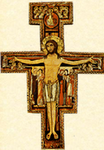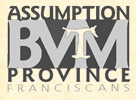Our Lady of Guadalupe
 Image of the Blessed Virgin Mary, Our Lady of Guadalupe, on Juan Diego's tilma ,in the Basilica in Mexico City
Image of the Blessed Virgin Mary, Our Lady of Guadalupe, on Juan Diego's tilma ,in the Basilica in Mexico City
La Virgen Morena is the famous celebration of the indigenous peoples of the Americas. She appeared to Juan Diego at Tepeyac, near the former Aztec capital and holy sites, over a series of days in December 1531, about 10 years after Hernán Cortéz and the Spanish conquistadores vanquished the once-proud Aztec people and several the other native peoples of México.
She spoke to Cuauhtlatoatzin, his Nahuatl (Aztec language: “one who speaks like an eagle”) name, in his native tongue, not in Spanish. Similarly, she appeared to him as one of his own, not as a European. She was swarthy, la Virgen morena (the dark-skinned Virgin).
The image of Our Lady of Guadalupe is very rich in symbols. Hers is an “icon”, if you will, not made by hands. Her image was miraculously imprinted on Juan Diego’s tunic, the tilma (a piece of clothing fashioned from the fibers of the maguey plant).
Unbeknownst to Juan Diego, when he displayed his tilma with the freshly picked roses, Bishop Juan Zumárraga, OFM (1st bishop of Mexico and a Franciscan friar and priest) was astonished, as were his friars!
The wonderful result of this heavenly visit was a powerful wave of evangelization. Millions of indigenous peoples, Aztec and beyond, professed faith in Jesus Christ and embraced the Catholic faith through the proclamation of the Gospel and were baptized. The story of the Blessed Mother’s arrival to their land and her message swept the land around Mexico.
Here was someone with whom the native peoples could identify. And still do to this day! When I am among Mexican Catholics, in their homes, businesses and even cars, I see Mary’s image, la Guadalupana! The story and her image are deeply ingrained in the consciousness of Mexican Catholics. And, December 12th is a national holiday in all of Mexico! Ser mexicano es ser guadalupano (to be Mexican is to be a devotee of Guadalupe!).
As we celebrate her feast day today, let us recall that Mary, the Mother of God, continues to intercede for us (as the position of her hands displays) and especially considers the poor and the downtrodden to be her special children. She is the pregnant Mother (the black sash around her waist) who came to a conquered people, the Aztecs. It was to them, not their conquerors, that she gave her message; to a peasant, not to an aristocrat or friar or bishop; in Nahuatl not Spanish.
To me, at least, it becomes another example of “minority” – the quality which was so dear to St. Francis of Assisi and which he tried to inculcate among his brothers, to whom he gave the name “minors” (friars minor – lesser brothers). The fruit of minority is solidarity. And this is our vocation as Franciscans!
We are preparing to celebrate the great festival of the Incarnation -- Christmas -- when the Word of God takes on human flesh, in solidarity with us. So great is God's love (see John 3:16).
God in Jesus Christ identifies with us! He becomes flesh of our flesh, bone of our bone, blood of our blood. Is this not true of what we celebrate sacramentally in the Eucharist, when we partake of the Body and Blood of Christ Jesus? The Lord himself feeds us with himself.
We ourselves might be quite surprised how the Lord desires to enter into our lives, to be in solidarity with us. Through the intercession of the Blessed Virgin Mary, our Lady of Guadalupe, may we all come to know the power of God’s grace in our very real human experience.



